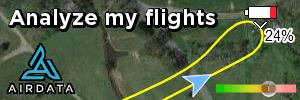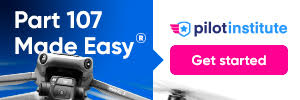Hello all!
As I wrote in the Introductions subforums, I'm a newbie to "real" quads. I had a toy Syma for a while, but went for the big upgrade and got a Phantom 3 Advanced. (I was originally aiming at the standard, but then I thought: "why not?")
I got it yesterday and this morning I had my maiden flight. It went reasonably well, but I was quite nervous; coming form the toy quad didn't help: my old Syma suffered from the "wind bug" and flew quite erratically.
Anyway, despite the lack of a perfectly clear and flat area, I found a reasonable place that would work: a field on a slight descending slope — it's hilly everywhere around here — and went for it. I did come home with both some interesting footage and some doubts, however, so I thought I'd ask here.
Apologies in advance for the length of this message: I don't mean to tax anyone's patience, but just asking a bunch of random questions with no context would probably be a waste of everybody's time.
Some of these may have been answered elsewhere but may not apply to my own case exactly, so I figured I'ask them again: I think that the fewer doubts I have next time I fly, the safer it'll be. I've been reading about Phantoms for over six months now, but actually going out and flying it a completely different thing!
1. My "pre-maiden" flight actually took place somewhere else close to that place, but it lasted only a minute as I quickly realized that I had too many trees to be safe. Before taking off the first time, the app didn't suggest to calibrate the compass so I didn't, as the P3A manual suggests only doing so when needed (which I assume to mean "when the app tells you so"). Is this correct?
After landing from that very brief flight, the app said to perform the calibration so I did the double-turn dance with the drone, which earned me a "whatever" look from my dog.
2. I then went to the aforementioned field, just a few minutes away on foot and I did not recalibrate the craft's compass as the app seemed happy the way it was: should I have calibrated it again anyway?
3. I used auto takeoff in GPS mode, with 13 satellites locked; during the flight it would lock as many as 19. it originally hovered at around 1.2 m as expected, but quickly started to drift away from me, and losing altitude. There was virtually no wind. Is it possible that the visual positioning system got somehow confused by the grass? Or perhaps it was a compass issue? The logs confirm I was in GPS mode all along and never went below the original 13 satellites. I have disabled VPS for the time being anyway, since I don't plan flying it without a GPS lock anyway.
4. I was overwhelmed, there's no denying that. Watching videos on youtube for months didn't prepare me for this. My main issue is that I honestly didn't know where to look: I took the "never lose sight of the aircraft" pretty seriously, especially I'm still not exactly at ease with the controls when the quad faces me. It does read out the alerts so my attention was quickly taken back to it whenever something happened, but in hindsight I realize I wasn't as attentive as I could have.
At some point I realized it was safe enough to try and compose a shot as I was filming all along, and climbed while looking at the screen, moving the gimbal and yawing to find myself (and my father and my dog, who wanted to witness the maiden flight). The app announced I had reached the maximum height of 30 meters that newbies are allowed, which was perfectly fine for me. I found us, then looked up, and... kind of freaked out. I don't know how some people shoot these things up to 100 meters or however high they go, I was there staring at this mechanical bird (mostly) hovering in place — it was actually more stable than it was closer to the ground — and thought "that's high! what if it drops dead and crashes and leaves a crater?"
I know, I'm exaggerating here and I'm 101% sure that in a few months I'll read this back and laugh at how scared I was, but any word of encouragement would be very welcome.
Mostly, I would like some advice on what to focus on: should the "keep it in your sight" be more like "glance at the rear view mirror while driving", i.e. something you to do make sure everything's safe, or should it be the main thing? Again, I'm aware this is probably silly and the most experienced amongst you are laughing, but I'm asking just because I take safety very seriously and want to do things properly.
5. At some point the craft went into RTH mode, then it said Landing: I'm honestly not sure why, as I didn't trigger either of those things. I may have hit the outer edge of the allowed range, but it should have just stayed there, I think. According to the flight log playback, I still had 65% battery (around 13 minutes) and was 20 m high and just 12 m from my home point. What may have triggered it? It took me completely by surprise and I can't see anything special in the logs about it.
6. At this point I was ready to call it a day, but since I had chosen a relatively cramped home point (a small concrete platform) and knew that RTH not exactly spot on, I decided to bring it where I wanted it to land, that is another patch of land just a few meters away. This is when I probably messed up a bit: instead of lowering it from 20 m to 7-8 m while bringing it closer to me, I mostly moved it horizontally; or perhaps I also tried to make it descend, but it didn't descend as much? I read that it's sort of the norm with quads, but I got lost in the aerodynamics there. Anyway I wound up with this bird — "what if it falls off" — pretty much right on top of me, which admittedly didn't help my sense of being overwhelmed.
Once over the designated landing spot, I decided to trigger auto-landing while it was 4 meters high, but as soon as the landing procedure started, it started drifting again in the same general direction as it had when it had taken off.
My mistake here was yawing the craft so it was facing me (don't ask me why, maybe I wanted to film myself? I'm honestly not sure), with the inevitable result that, as I tried to take it back to the landing spot I managed to have it topple over as soon as it touched the soil on the slope. No damage at all, just dirty props: I cleaned them and briefly tried taking off again and it worked fine.
The question remains: why did it drift like that? And, generally, what is the "correct" procedure regarding distance and height at the end of a flight?
Wow, if you made it this far then thank you already and apologies again for the long read; I promise I'll be more to the point in my next posts. I hope that you had a good laugh at least!
Any advice is more than welcome.
Thanks in advance!
As I wrote in the Introductions subforums, I'm a newbie to "real" quads. I had a toy Syma for a while, but went for the big upgrade and got a Phantom 3 Advanced. (I was originally aiming at the standard, but then I thought: "why not?")
I got it yesterday and this morning I had my maiden flight. It went reasonably well, but I was quite nervous; coming form the toy quad didn't help: my old Syma suffered from the "wind bug" and flew quite erratically.
Anyway, despite the lack of a perfectly clear and flat area, I found a reasonable place that would work: a field on a slight descending slope — it's hilly everywhere around here — and went for it. I did come home with both some interesting footage and some doubts, however, so I thought I'd ask here.
Apologies in advance for the length of this message: I don't mean to tax anyone's patience, but just asking a bunch of random questions with no context would probably be a waste of everybody's time.
Some of these may have been answered elsewhere but may not apply to my own case exactly, so I figured I'ask them again: I think that the fewer doubts I have next time I fly, the safer it'll be. I've been reading about Phantoms for over six months now, but actually going out and flying it a completely different thing!
1. My "pre-maiden" flight actually took place somewhere else close to that place, but it lasted only a minute as I quickly realized that I had too many trees to be safe. Before taking off the first time, the app didn't suggest to calibrate the compass so I didn't, as the P3A manual suggests only doing so when needed (which I assume to mean "when the app tells you so"). Is this correct?
After landing from that very brief flight, the app said to perform the calibration so I did the double-turn dance with the drone, which earned me a "whatever" look from my dog.
2. I then went to the aforementioned field, just a few minutes away on foot and I did not recalibrate the craft's compass as the app seemed happy the way it was: should I have calibrated it again anyway?
3. I used auto takeoff in GPS mode, with 13 satellites locked; during the flight it would lock as many as 19. it originally hovered at around 1.2 m as expected, but quickly started to drift away from me, and losing altitude. There was virtually no wind. Is it possible that the visual positioning system got somehow confused by the grass? Or perhaps it was a compass issue? The logs confirm I was in GPS mode all along and never went below the original 13 satellites. I have disabled VPS for the time being anyway, since I don't plan flying it without a GPS lock anyway.
4. I was overwhelmed, there's no denying that. Watching videos on youtube for months didn't prepare me for this. My main issue is that I honestly didn't know where to look: I took the "never lose sight of the aircraft" pretty seriously, especially I'm still not exactly at ease with the controls when the quad faces me. It does read out the alerts so my attention was quickly taken back to it whenever something happened, but in hindsight I realize I wasn't as attentive as I could have.
At some point I realized it was safe enough to try and compose a shot as I was filming all along, and climbed while looking at the screen, moving the gimbal and yawing to find myself (and my father and my dog, who wanted to witness the maiden flight). The app announced I had reached the maximum height of 30 meters that newbies are allowed, which was perfectly fine for me. I found us, then looked up, and... kind of freaked out. I don't know how some people shoot these things up to 100 meters or however high they go, I was there staring at this mechanical bird (mostly) hovering in place — it was actually more stable than it was closer to the ground — and thought "that's high! what if it drops dead and crashes and leaves a crater?"
I know, I'm exaggerating here and I'm 101% sure that in a few months I'll read this back and laugh at how scared I was, but any word of encouragement would be very welcome.
Mostly, I would like some advice on what to focus on: should the "keep it in your sight" be more like "glance at the rear view mirror while driving", i.e. something you to do make sure everything's safe, or should it be the main thing? Again, I'm aware this is probably silly and the most experienced amongst you are laughing, but I'm asking just because I take safety very seriously and want to do things properly.
5. At some point the craft went into RTH mode, then it said Landing: I'm honestly not sure why, as I didn't trigger either of those things. I may have hit the outer edge of the allowed range, but it should have just stayed there, I think. According to the flight log playback, I still had 65% battery (around 13 minutes) and was 20 m high and just 12 m from my home point. What may have triggered it? It took me completely by surprise and I can't see anything special in the logs about it.
6. At this point I was ready to call it a day, but since I had chosen a relatively cramped home point (a small concrete platform) and knew that RTH not exactly spot on, I decided to bring it where I wanted it to land, that is another patch of land just a few meters away. This is when I probably messed up a bit: instead of lowering it from 20 m to 7-8 m while bringing it closer to me, I mostly moved it horizontally; or perhaps I also tried to make it descend, but it didn't descend as much? I read that it's sort of the norm with quads, but I got lost in the aerodynamics there. Anyway I wound up with this bird — "what if it falls off" — pretty much right on top of me, which admittedly didn't help my sense of being overwhelmed.
Once over the designated landing spot, I decided to trigger auto-landing while it was 4 meters high, but as soon as the landing procedure started, it started drifting again in the same general direction as it had when it had taken off.
My mistake here was yawing the craft so it was facing me (don't ask me why, maybe I wanted to film myself? I'm honestly not sure), with the inevitable result that, as I tried to take it back to the landing spot I managed to have it topple over as soon as it touched the soil on the slope. No damage at all, just dirty props: I cleaned them and briefly tried taking off again and it worked fine.
The question remains: why did it drift like that? And, generally, what is the "correct" procedure regarding distance and height at the end of a flight?
Wow, if you made it this far then thank you already and apologies again for the long read; I promise I'll be more to the point in my next posts. I hope that you had a good laugh at least!
Any advice is more than welcome.
Thanks in advance!





